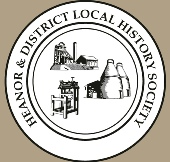
Heanor & District Local History Society
The Midland General Story
The Nottinghamshire and Derbyshire Tramways Company was formed in 1903 by Act of
Parliament. It was not until 1913 that the tramway from Ripley to Nottingham, via
Langley Mill, Eastwood and Kimberley, was finally opened, the capital being funded
by Balfour, Beatty & Co., of Ilkeston. The laying of the tramlines was a major project
- many of the bridges which can been seen along the route date from this time (for
example, the bridge over the canal at Langley Mill, which had previously been a wooden
construction), and many old buildings were demolished for road-widening (e.g. the
Crown and White Hart pubs at Heanor). Initially, the trams only ran as far as Cinderhill/Basford,
where people had to switch to trams of the Nottingham Corporation, but later the
city allowed Notts and Derbys trams to pass over its rails. The long route from Ripley
was a single track, with 316 passing places along the route to allow trams to pass
in the opposite direction. As other forms of transport developed, this limitation
to the trams caused their demise. In 1916, the company also took over the Ilkeston
Corporation Tramways, but the routes of the two companies never joined.
|
Tram Fares, 1913
"Penny fares will be available between the following places:
Ripley and Codnor Gate
Codnor Gate and Crosshill Station
Crosshill Station & Loscoe Crossing
Loscoe Crossing and Heanor Market Place
Heanor Market Place and Langley Mill Station
Langley Mill Station and Eastwood Market Place
Eastwood Market Place and Newthorpe Common Lane
Newthorpe Common Lane and Greasley Schools
Level Crossing and James St, Kimberley
James St and Alfreton Rd
Alfreton Rd and Lodge
Lodge and Dark Lane
Dark Lane and Church St
|
Five consecutive stages will be given for 4d, six for 5d, seven for 6d, and eight
for 7d. When ten consecutive stages are taken, the fare will be reduced to 8d...
An elevenpenny ticket will take the passenger from Ripley to Church Street, Basford.
Workman's tickets are issued at half the normal rates.
A charge of 1d will be made for parcels and dogs, the latter being allowed only outside
the car."
(Heanor Observer, 31 July 1913)
|

Notts and Derbys Tram opposite Loscoe Post Office, 1914
During the 1920's, the improved performance of motor transport gave significant competition
to the trams from the many early omnibus companies. Not to be left out, in 1920 Balfour
Beatty established the Midland General Omnibus Company (it was initially called the
General, but changed its name after buying the Midland Bus Company from Kimberley).
The M.G.O. shared the Notts & Derbys base at Langley Mill, still used today as a
bus depot. The three Balfour Beatty companies, the Midland General Omnibus Company,
the Notts and Derbys Tramways Company and the older Mansfield District Traction Company,
formed a single group of companies called the Midland General Group. The Midland
General snapped up many of the smaller companies in the area in the 20's and 30's,
taking over Brewin and Hudson of Heanor, Williamson & Son of Heanor, J.T.Boam of
Ilkeston, and the Heanor & District Omnibus Company.
By 1928, Notts & Derbys was given power to operate a trolley bus system in the area.
The first trolley buses were introduced in 1931, and on 5 October 1933 the last tram
ran on the Nottingham to Ripley route.
The trolley bus system was very efficient and reliable, the journey from Ripley to
Nottingham taking 90 minutes, with some 230 stops along the way.
Trolley buses continued until 25 April 1953, when they too gave way to the increased
versatility of the bus. The fleet of trolley buses was sold to Bradford Corporation.
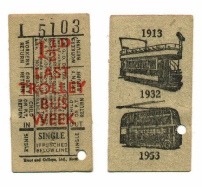
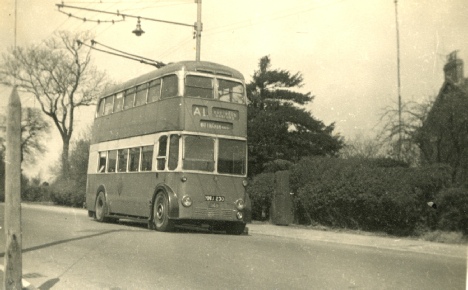
A1 trolleybus at Crosshill during the last week of commission,
April 1953.
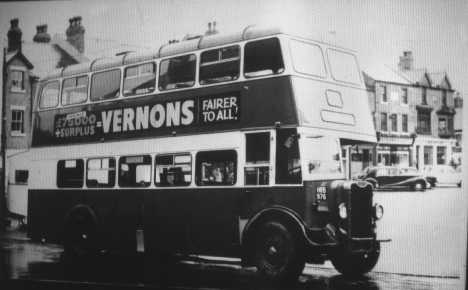
MGO bus on Heanor Market Place
In 1948, ownership of the Midland General Group had been passed to the the British
Transport Commission. In 1962 the Transport Holding Company took over, and, on 1
January 1969, the Midland General became part of the National Bus Company. The other
large local bus company, Trent, also became part of the National Bus Company, and
the decision was made to combine the two companies, using the Trent colours. The
companies merged in 1972, and by 1978 the last MGO blue bus had been repainted.

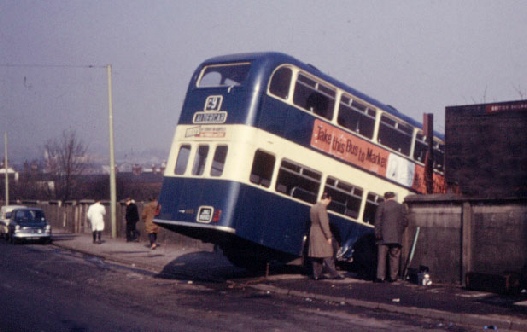
An unfortunate event for the C9 on its way to Aldercar.
This Midland General bus in full company colours came a cropper at the old Eastwood
and Langley Mill Station, near to the Great Northern in 1969.
When we first posted this photograph on our website, it attracted a lot of attention
focally and from around the world. Several emails were received naming the driver,
but we weren’t going to post those details. Imagine, then, how delighted we were
to receive a full account of the accident from the man himself, Glyn Pickworth, along
with another picture! Here’s Glyn’s story…
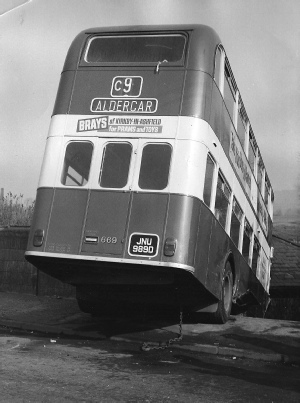
"I was 15 years old when I left school and went to train and work for the Midland
General Omnibus Company as a 'Fitter/Turner'. One of the company's minimum requirements
to be able to drive any vehicle for the company, was to have, or train for, a PSV
licence, and also to agree to fill in as a driver as, and when, required. I got my
PSV licence at the age of 21.
In 1969, I was 26 years of age. I had been asked to drive the MGO. double decker
bus on the C9 run - the last bus from Hucknall to Aldercar. Apart from myself and
the bus conductress, Jean Clark (now deceased), there were two other passengers on
board - a girl and Peter Meakin, a work colleague.
As I approached the Langley Mill Station corner, an Austin Healey 3000 sports car
came zooming towards me, on the wrong side of the road as it overtook a Vauxhall
Victor. It crashed into my bus, knocking the front off-side wheel back, and turning
the bus into the station. Before hitting the station, the bus also collided with
the Victor. The bus's steering wheel twisted like a figure of eight on impact. My
right hand went through the windscreen as I was thrown forward and was bleeding profusely.
I wanted to check that my passengers were alright and I struggled to get out of my
driving seat. The Austin Healey which was about 60/70 yards away burst into flames.
Someone called the emergency services and an ambulance took me and others to hospital
to be checked over. Amazingly there were no fatalities. I was back home from hospital
by the time the police came knocking to get all the details. I was black and blue
all over the next day and could hardly move. I was off work for about a month in
all and, on my return, my first job was to repair that same bus with a new chassis.
My only reminder of it all - apart from memories - is a deformed right forefinger.
However, now I find, quite by chance, that it's all on the website, bringing the
possibility of 'world fame' ever nearer!!!!!!"







